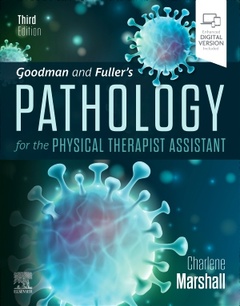Description
Goodman and Fuller's Pathology for the Physical Therapist Assistant (3rd Ed.)
Author: Marshall Charlene
Language: English
Subject for Goodman and Fuller's Pathology for the Physical...:
832 p. · 19x23.3 cm · Paperback
Description
/li>Contents
/li>
Gain an understanding of diseases and disorders to effectively assist the Physical Therapist! Goodman and Fuller's Pathology for the Physical Therapist Assistant, 3rd Edition provides a solid background in pathology concepts and how they affect the role of the PTA in client rehabilitation. With an easy-to-read approach, chapters define each disease or systemic disorder, then describe appropriate physical therapy assessments plus guidelines, precautions, and contraindications for interventions. Case studies show how treatment ideas may be applied in everyday practice. From PTA educator Charlene M. Marshall, this market-leading pathology text provides the practical tools required to treat patients knowledgeably and effectively. It also includes a fully searchable eBook version with each print purchase.
- Concise information on disease processes and systemic disorders provides a background in the underlying pathology of diseases, helping PTAs to ask their patients appropriate questions and to adapt therapeutic exercise programs.
- Easy-to-follow format is organized to first define each disorder, followed by sections on clinical manifestations and medical management.
- Chapter objectives, outlines, and vocab builders at the beginning of each chapter introduce the topics and terminology to be presented.
- Medical Management sections address diagnosis, treatment, and prognosis for each condition discussed.
- Focus on the Physical Therapist Assistant's role provides the PTA with specific guidelines to the rehabilitation process for patients with diseases and disorders.
- Special Implications for the PTAsections allow students to easily reference information on working with patients with specific diseases or pathologic conditions.
- Nearly 800 drawings and photos reinforce student understanding of diseases, conditions, and general pathology principles.
- Standardized terminology and language is consistent with the Guide to Physical Therapy Practice, familiarizing readers with the standard terminology used in PT practice.
- Abundance of tables and boxes summarize important points, making it easy to access key information.
- E-chapters add supplemental information on behavioral and environmental factors, the gastrointestinal system, the reproductive system, lab tests and values, and more.
- NEW! Updated and revised content throughout provides students with the current information they need to be effective clinicians.
- NEW! Clinical Pharmacology Spotlight provides an easy-reference summary of the basic pharmacology information for each pathology.
- NEW! eBook version is included with print purchase. The eBook allows students to access all of the text, figures, and references, with the ability to search, customize content, make notes and highlights, and have content read aloud.
1 Introduction to Concepts of Pathology
2 Problems Affecting Multiple Systems
3 Injury, Inflammation, and Healing
Section Two Clinical Medicine
4 The Immune System
5 Infectious Disease
6 Oncology
7 The Integumentary System
8 The Endocrine and Metabolic Systems
9 The Integumentary System
10 The Hematologic System
11 The Respiratory System
12 The Hepatic, Pancreatic, and Biliary Systems
Section Three Pathology of the Musculoskeletal System
13 Introduction to Pathology of the Musculoskeletal System
14 Genetic and Developmental Disorders
15 Infectious Diseases of the Musculoskeletal System
16 Musculoskeletal Neoplasms
17 Bone, Joint, and Soft Tissue Diseases and Disorders
Section Four Pathology of the Nervous System
18 Introduction to Central Nervous System Disorders
19 Infectious Disorders of the Central Nervous System
20 Degenerative Diseases of the Central Nervous System
21 Stroke
22 Traumatic Brain Injury
23 Traumatic Spinal Cord Injury
24 Cerebral Palsy
25 The Peripheral Nervous System
These books may interest you

Introduction to Physical Therapy 85.05 €



